Disclosure: Meeple Mountain received a free copy of this product in exchange for an honest, unbiased review. This review is not intended to be an endorsement.
During Gen Con 2023, I picked up a review copy of Amun-Re: 20th Anniversary Edition from Alley Cat Games. Alley Cat has done us right here at Meeple Mountain. Bob (and I, separately) really enjoyed Tinners’ Trail, and I had the chance to cover last year’s strong-yet-component-fiddly economic Euro Autobahn. A few of my friends swear by Dice Hospital, a game I had the chance to try last year on Board Game Arena.
In all of those cases, I thought Alley Cat’s team did excellent work with the production and the extras; in each game that I’ve played (included Amun-Re), there are a few mini-modules included in each box. In the case of both Autobahn and Tinners’ Trail, the solo modes were excellent. With Alley Cat, theirs is a team I grow more and more excited about with each game.
So when I signed up to do a full play of Amun-Re at Gen Con, I expected to continue loving what I saw. Then the teach began, and our teacher (who had survived a long day at the demo table, given the look of fatigue) really blew it during our five-player game. Missed at least a half-dozen rules, a couple of them pretty significant. Kept bouncing between two tables, and it felt like each table had a lot of questions.
We got through half of a normal game, and called it because a couple players needed to run to their next scheduled play. I was worried. As we saw it, Amun-Re wasn’t that interesting. But Reiner Knizia was involved…in a game that is clearly a classic if it’s being brought back to life 20 years after its original release. What was I missing?
As it turned out, I was simply missing many of the most important rules. When we got the game back to my lab in the Chicagoland area, I put Amun-Re back on the table right away, and I am very excited to say that it is fantastic.
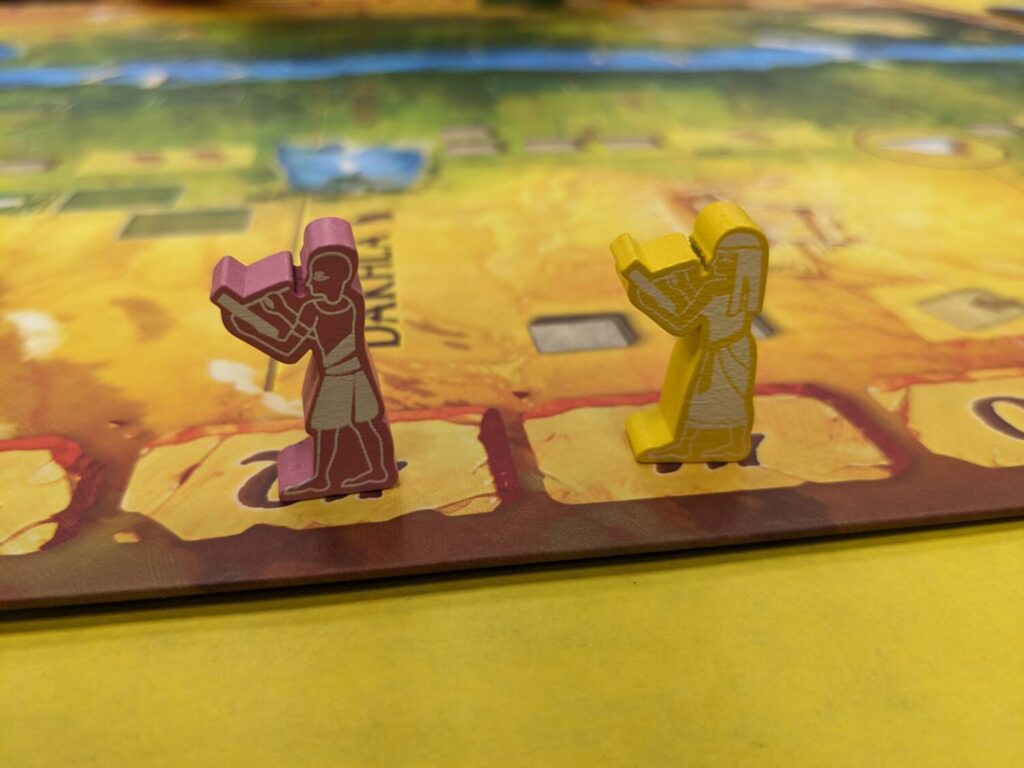
Ray, You Say?
Amun-Re was first published in 2003, and at that stage, designer Reiner Knizia had only published about 500 games during his fledgling tabletop career. (I kid. Sort of.) By 2003, Ra, Tigris & Euphrates, and High Society had all hit with fans, so Amun-Re must have arrived with a decent amount of fanfare.
I love that Amun-Re has come back into print because it allows gamers like me—seasoned, but by no means a tenured expert with games published in the 1980s, 90s, and 00s—to give some of these classics a look with fresh eyes.
Amun-Re puts players in the shoes of pharaohs aiming to build the most extensive legacy over the course of two ages, spread across six rounds. Both halves of the game are the same—take three turns to auction various regions using a hand of gold cards. Then, take control of the provinces scattered across the map, buy scoring cards, building materials, farmers and characters to influence actions, then contribute to the Amun-Re temple before collecting money for your efforts.
In this way, Amun-Re is a bit like Ra, my favorite Knizia design. The auction phase is very interesting and leads to fun battles with other players because money is (relatively) secret during play. Using a mechanic that was later used in games like Stockpile, players have access to regions equal to the number of players in each round. Four-player game, four regions available for bid.
Each card has a bidding track that starts at zero, and goes up from there. The first player has access to all of the regions and can pick a card and a bid amount that essentially boxes other players out for that region…but that might also mean other players later in turn order could take a region without paying a cent. When a player is outbid, they get to move their bidding marker to a different region card. This continues until each player has one region to take on as their own.
Then players go to market. Buying farmers for field spaces (yes…”farmers” for “fields”) generates coins at the end of the round. Bricks can be bought to be turned into pyramids. (Pyramid building is that simple in this game; three bricks magically turn into decades’ worth of real-life labor. Amun-Re doesn’t want to deal with some of those tougher questions, and given my emotional strength at the end of a long work day, neither do I…it’s a game.)
The third thing you can buy at the market: Favor cards. These cards grant players scoring opportunities and character cards that provide slight advantages to the owner during specific times each game. These Favor cards are a mix of mid- and end-game scoring cards called Schemes, which grant three points each for meeting certain conditions and only unique Schemes can be scored. (So, hoarding Schemes of the same type to score three points per card is not allowed.)
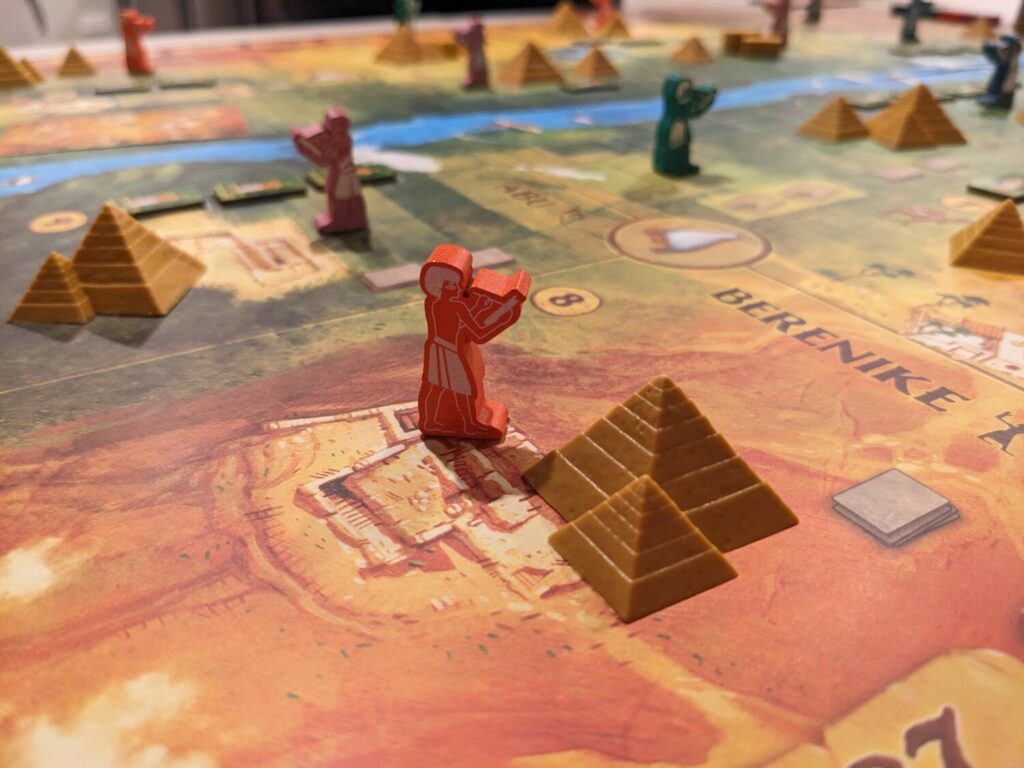
The other Favor cards provide powers. Architects provide a pyramid building discount. Theft cards let players steal gold instead of contributing to the temple of Amun-Re. All players begin the game with an Architect card and a Theft card. Another power, Abundance, earns one gold more for each farmer in a specific province. Using these powers provide a minor edge, but I find that these minor edges really add up over the course of a full game.
After players go shopping, everyone gets to bid a certain number of gold coins towards the building of the temple. Players can also use a Theft card instead of bidding, to bring the overall contribution total down. The highest contributor during this phase becomes first player and gets a number of gifts (a mix of Favor cards, bricks, and Farmers), but because turn order stays relative and multiple players sometimes play their Theft card, we have had games where the second-highest bidder was actually a simple thief!! Higher contribution totals drive the amount of money each Farmer will earn…but watching players who have no Farmers helps for planning purposes.
During the Harvest phase, everyone collects money based on certain board bonuses, such as the Mine, which grants province owners a certain number of coins. Everyone also gets paid 1-4 coins for each Farmer they have on a field, including some that are pre-printed on the board.
These four phases happen each round. At the end of the first and second age (after rounds three and six), a mid-game scoring known as Province scoring takes place. Provinces with the most temples and sets of temples get a payout, and all Scheme cards pay out now as well. One other item scores during Province scoring: Temples.
A few of the provinces have a temple pre-printed in the bonus area of that space. Each temple scores 1-4 points, based on the current position of the temple of Amun-Re at the end of the third round or the sixth round. This is a very sneaky way to score extra points because it takes a little more work to recognize that a player may be specializing in this area. I’m not sure if I like that or not, but I appreciate that this is an option!
In the sixth round, one additional scoring mechanic becomes available: gold scoring. The player with the highest amount of leftover gold, typically earned during the final harvest phase, gets a six-point bonus, with smaller bonuses given to the second- and third-highest finisher.
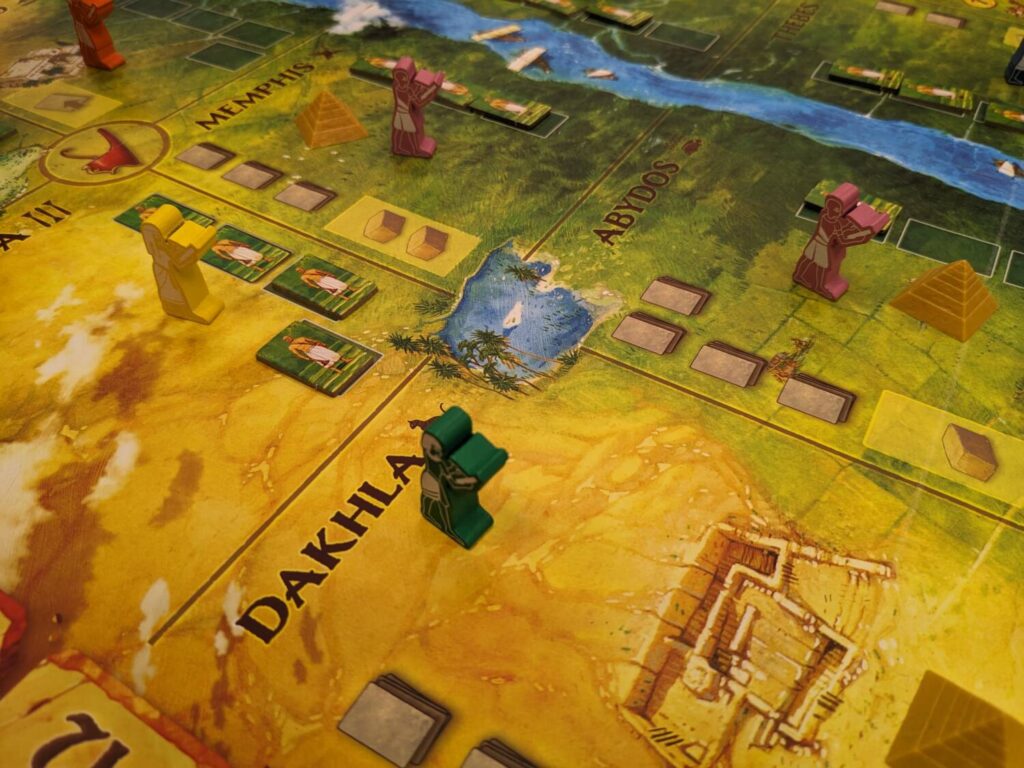
Simple, and Not Simple
Amun-Re is a pretty quick teach; maybe 10 minutes, depending on a gamer’s familiarity with auction and area control scoring mechanics. But there is so much here!
The auction phase is a quick but very consequential mind game. Sometimes I have watched players “ball fake” competitors by bidding on a province they really don’t want to end up with, hoping to be outbid to snake a spot that really does fit into the goals of their Scheme cards. Some of the card powers allow a player to bid on a card then block the next highest bidding spot, meaning that a competitor has to bid two spots higher to claim a card. This might become a significant financial investment that may or may not pay off.
Buying stuff is quick; the ability to burn any Favor cards for one coin per card provides flexibility with cards that may no longer be useful. The Offering phase is sometimes fascinating as players jockey to affect Amun-Re’s scoring mechanic.
Amun-Re becomes quite a thrill ride, with every decision having real weight in a playtime that ranged from 60-90 minutes in my plays (at two, four and five players). At four or five players, I think you get the “real” Amun-Re experience. A tighter bidding world, limited space to achieve your goals, and with a full map available, lots of jousting for position in the second half of the game for those pyramid-rich provinces that have the best bonuses.
My single play at two players was less ideal, though. The game forces players to use a variant known as the Officials variant, which changes the auction phase and offers bonuses for territories that are not won during this phase. It was OK, but it’s not the ideal way to learn, let alone play, Amun-Re. Bidding games are always better with a high player count, and Amun-Re is no exception.
I like that the option is here for a game with less than four players, but it’s not an option I will use now that I’ve seen the game at max count.
Amun-Re 20th Anniversary Edition has a fantastic rulebook with a linen finish, stellar artwork on the cards (Vincent Dutrait brings his typically excellent work to this upscaled edition), and maybe my favorite production touch: character cards color coded to the phase in which they can be played. There should be at least one additional player aid in the box to call out the symbols on the Scheme and character cards; the lack of iconography aids always leads to players passing the rulebook around the table, which is annoying after a few rounds.
The overall strength of this production, added to gameplay that has aged well, means you’ve got a solid package for a fair price. Amun-Re is an easy recommendation, both for players new to the property and those looking to update an old copy of the game they already own. I’m already excited for future plays of this approachable, deep design!


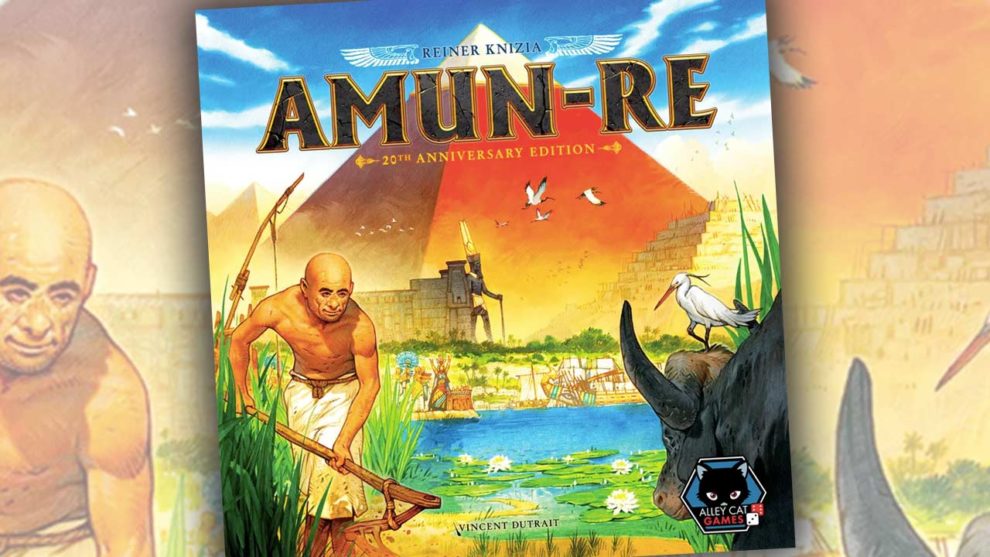




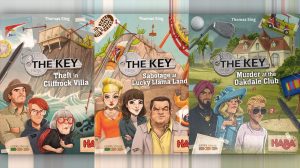




Add Comment